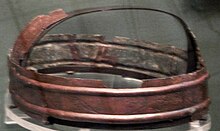Deal Warrior
The grave, dated to around 250 to 150 BCE, contained the skeleton of a man in his thirties, short and slightly built.
The quality of these finds suggests the grave was a high status burial, as swords were an expensive item available only to the aristocracy and their retainers, and the wealthier freemen.
A connection has been drawn between this crown and headdresses found in later Romano-British religious sites at Hockwold, Norfolk, and Wanborough, Surrey.
It also bears a resemblance to descriptions of Iron Age antiquarian finds from Newnham Croft, Cambridgeshire, Old Castle Down, Glamorganshire and Cerrig-y-Drudion, Clwyd.
The implied religious connection has led some historians to suggest that the Deal Warrior may well have been a druid, a member of the pre-Roman British intellectual and priestly class.
